Release Management
This section of the console allows you to manage your app's releases, which are based on the Release Channels model.
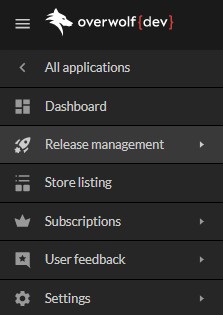
What are Release Channels
The Release Channels model allow for the deployment of multiple different versions of your code, with minimal overhead for both developers and users.
We can take the Overwolf client as an example:
- The public channel (used when the channel name is empty), serves as the public "version". Users will default to this channel.
- The developer's channel (used when the channel name is
Developers), is the "version" aimed at developers, getting new releases before they reach the public channel, so developers can adapt their apps to them.
Similarly to that, the developers console allows you to create and manage your app's own release channels, or App Channels for short.
App Channel features
App Channels allow you to control several aspects of your deployment:
- Phasing (Rollout) - You can release new updates to a % of the users on a channel at a time.
- Automatic deployment - No need for update checks, manual updating, etc. As long as it's set in the console, Overwolf will take care of the rest.
- One place for everything - For every version in a channel, you can view the download counts, active user counts, phasing history, internal and external changelogs, and even download the actual opk file.
- Automatic version diffs - The developers console will maintain version "diff" files a few versions back on every channel, significantly reducing the file size for app updates.
Keep in mind that app channels can take a few minutes from the moment a version was rolled out, until the version will be available for the selected clients.
The "Production" and "Testing" Environments
For an Overwolf app, channels are split into two groups, that operate similarly:
Production- Your app's public channelTesting- Your app's testing channels
Changing App Channels
There are two ways that your testers/users can get the custom app version from a specific channel:
- Custom download link - Get the custom download link from the dev console.
- For the Production channel, this will be the app's unique download link.
- For Testing channels, this will be the channel's unique download link.
- API - Use the Overwolf API as explained below to change the current app channel, enabling you to integrate this feature into your app. For example, you can display a combo box that enables your app users to change the channel from the app's UI.
Apply the channel change
After downloading the custom app version or changing the app channel, you will have to do ONE of the following to apply the change:
- Restart the Overwolf client.
- Wait up to four hours for the auto-update process to initiate.
- Update the app through the API and relaunch it, using the recommended extension update flow.
Rollout/Phasing
Phasing allows you to gradually deploy new app versions to their channels.
This works by having up to two "active" versions of the app per channel.
- The channel's "live" version. It is fully rolled out, and users will default to it.
- For test channels, if there is no "live" version, the production channel's "live" version will be used instead.
- The channel's "phased" version. It is partially rolled out. This version only exists during phasing of a new version.
Users subscribed to the channel will then be chosen at random to download the phased version.
The portion of users chosen corresponds to the phasing % for the version. As the phasing increases, new users will be chosen to download the version.
- A "phased" version's phasing cannot be decreased. It can only be increased.
- The "phased" version's phasing can be
Halted. OnceHalted, no new downloads of the version will occur, even to users that were chosen to be phased to.- The "phasing" can then be
Resumed, at which point, it will return to acting the way that it should.
- The "phasing" can then be
- If a new version begins rollout, it will replace the "phasing" version if it exists.
When that happens, the old "phased" version's rollout will be considered
Halted.Users on the old "phased" version will stay on that version as their "live" version. They will not be rolled back.
New users from this point onwards will only be split between the "live" version and the new "phased" version.
Keep in mind that the new "phased" version will randomly choose a different set of users.
In order to guarantee a move of all users on the old "phased" version, you will need to release a newer version, and roll it out fully.
- Once the "phased" version's phasing becomes 100%, it will replace the "live" version.
Manage An App Channel
Every App Channel, once entered, will contain these three sections:
- New Release - Upload a new app version
- Public Releases - Manage the currently live versions in the channel
- Release History - Manage past app versions
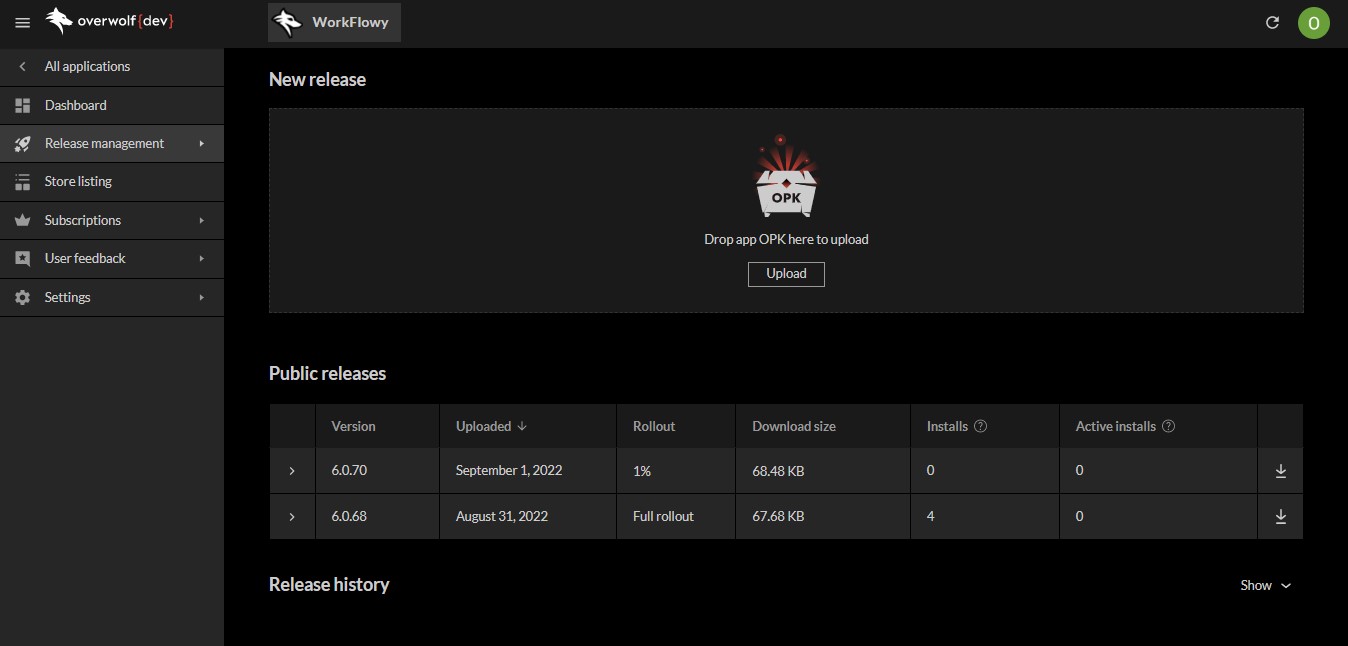
New Release
Ready for release
This is where you can upload a new version of your app. Before we get started, make sure you have a valid .opk file for the new version. You can learn more about creating a new .opk file here.

By dragging an .opk file (or clicking Upload and selecting one), we can begin a new version release "draft".

Once the file is done processing, assuming that everything went right, we will be greeted by the following screen:
Review
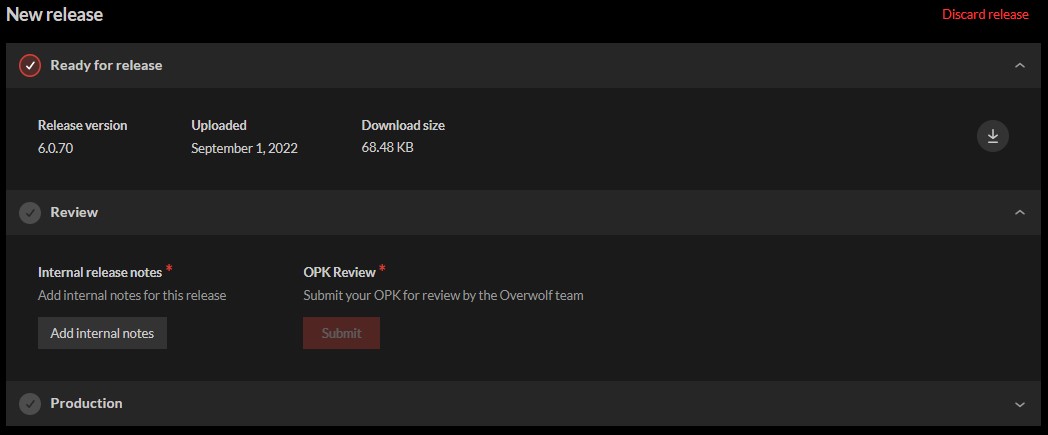
As mentioned under App version review, after enough releases, an app can start releasing new versions without review. In that case, the Review step becocmes optional, and we can skip directly to the Production step.
- Test Channels are always exempt from mandatory version reviews!
It is recommended to submit major versions for review, even if reviews are no longer mandatory!
In here, we will need to add the internal release notes for this version by pressing Add internal notes. These release notes will only be viewable by your app's team, and the Overwolf team.
Once the release notes are added, the screen will change, and allow us to send the new version for review.
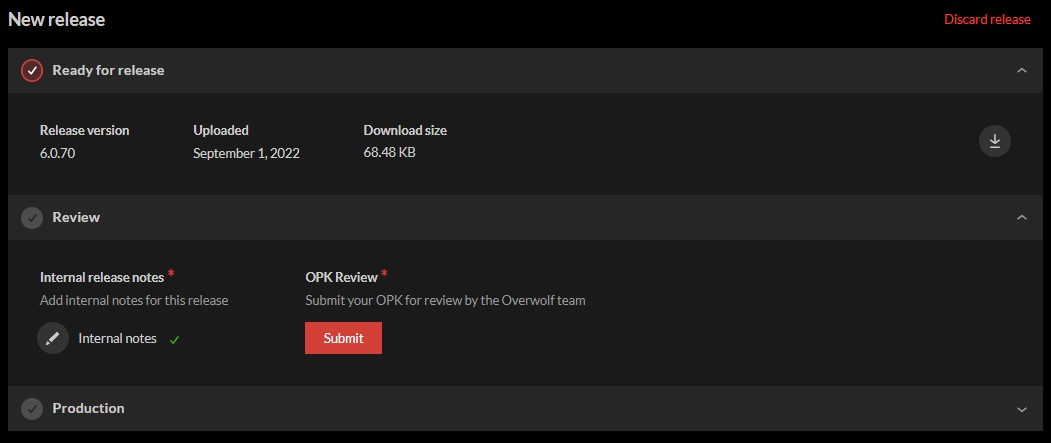
Once we press Submit, the app will be sent for review by the Overwolf team, and the screen will change. If at any point, we wish to pull the review back, we can cancel it by pressing Cancel Request.
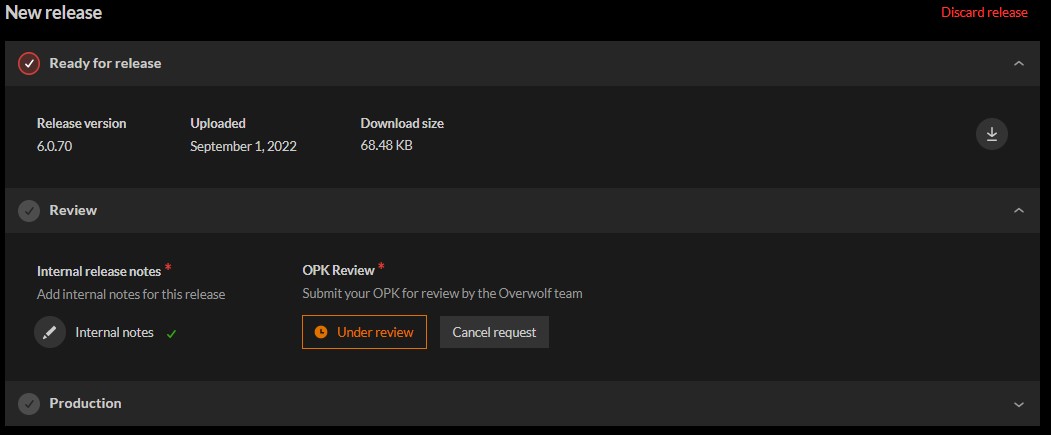
Once our version gets approved, the screen will change, and we will be able to start releasing the version.
Production
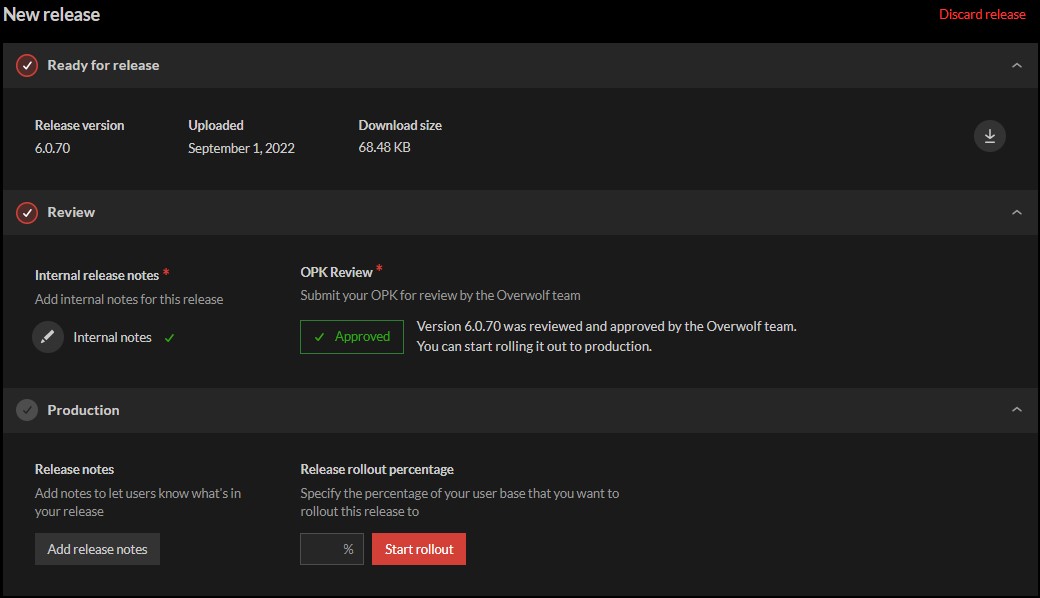
From here, we can (and should) add public release notes under Add release notes, and we can start specifying the rollout % in the relevant textbox, and save it by clicking on Start rollout.
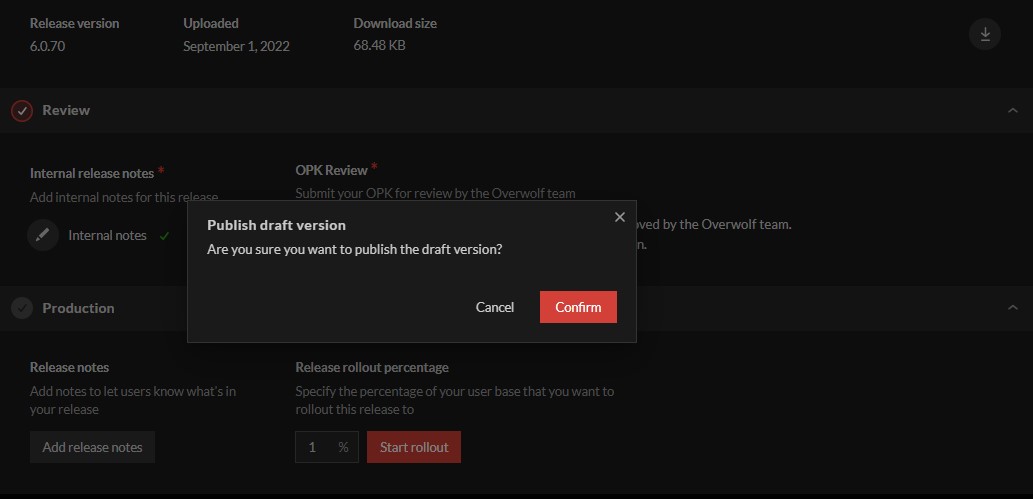
Once we click Confirm, the release will come out of "draft" mode, and become a full release, sitting under Public Releases.
If at any point throughout the process, we decide that we wish to discard this version's draft, we can always click on the red Discard release text in the top right.
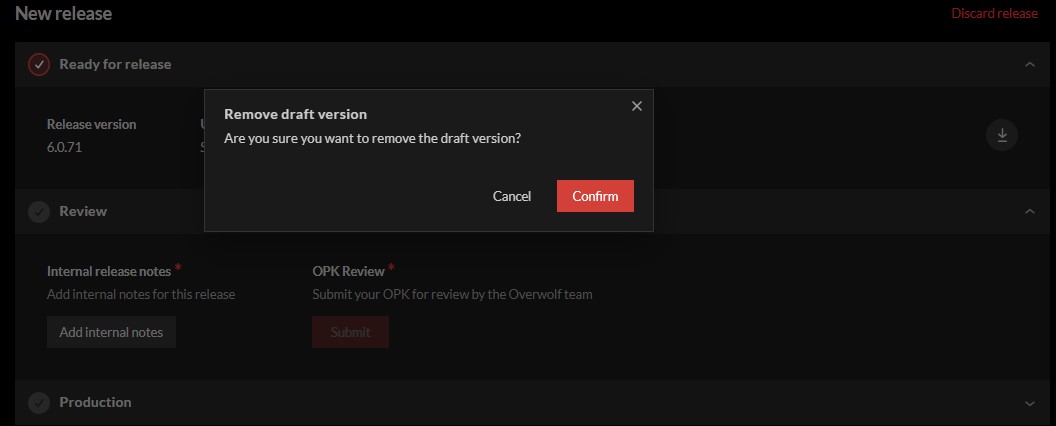
Then, once we click Confirm, the draft will be deleted.
Public Releases
Under Public Releases, you can manage the currently active versions.
- Opened
- Closed
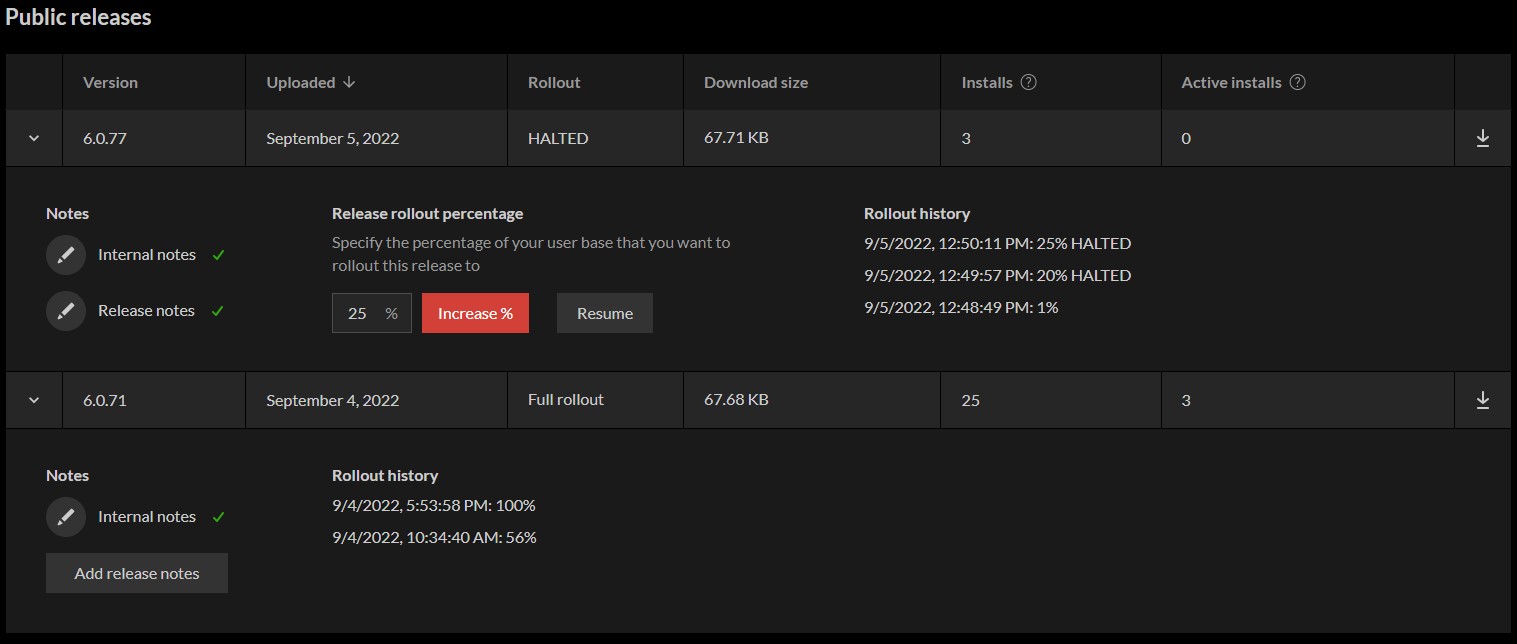

Release History
Under Release History, you can get an overview of historical versions.
Historical versions are split into pages, using The Paging Footer.
- Opened
- Closed

Here, you can
- Browse the different pages of older releases (in the bottom right)
- See a total of all versions, and change the amount displayed per page (in the bottom left)
Version Overview

Information about a specific version. Includes:
- Version - The app version associated with this version.
- Uploaded - When was this version uploaded.
- Rollout (Only shows up on active versions) - What is the current rollout status of this version. Possible values include:
- Download size - The size of the raw opk file for this version.
- Installs - How many (non-unique) installations of this version have ever occured.
- Active Installs - How many active installations exist for this version. This means installations that were active in the last 30 days.
Notes
- Empty
- Filled
Release rollout percentage
This section only appears on the "phasing" version. If will not appear on any other version.
Release rollout percentage
Rollout History
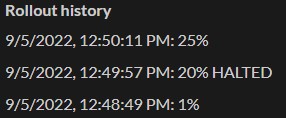 A list of all rollout changes for this version, including:
A list of all rollout changes for this version, including:
- Date - When was the change made.
- Rollout - How much was the rollout increased to.
- Halted or not - Is the version halted (for changes before the latest, this will count whether or not they were halted when changed to the next %).
Release Notes
There are two kinds of version release notes:
- "Internal release notes" - These are used for documenting all changes done to the app over time. They can only be viewed by your app's staff and the Overwolf team.
- "(Public) release notes" - These are your app's public release notes, for documenting public changes to the app. They can be viewed by anyone, even outside of the developer's console, and it is recommended to use them to manage your app's public "changelog" for new versions.
Edit Release Notes
Release notes are edited using CommonMark, with a rich text editor.
Release Notes Editor
- Edit
- Preview
The text editor has a Preview button, which, when pressed, will switch the release notes into preview mode.
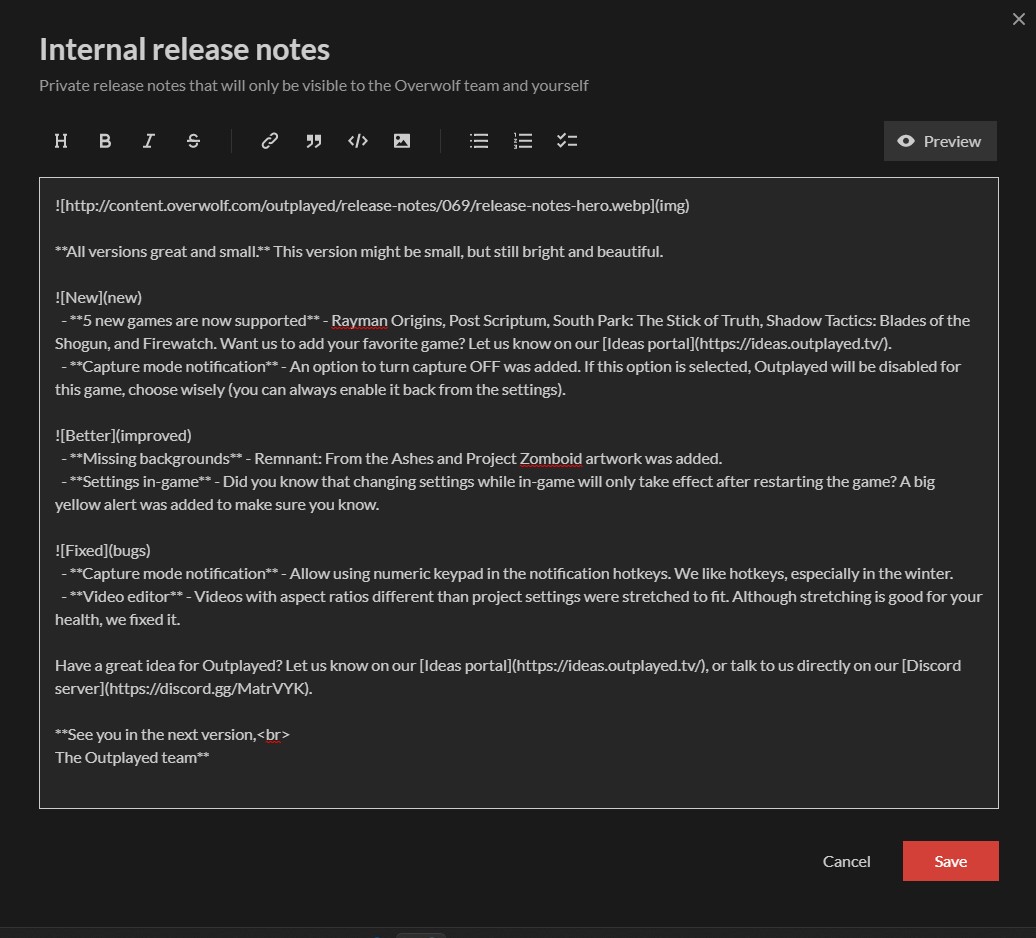
The preview mode has an Edit button, which, when pressed, will switch the release notes back into edit mode.
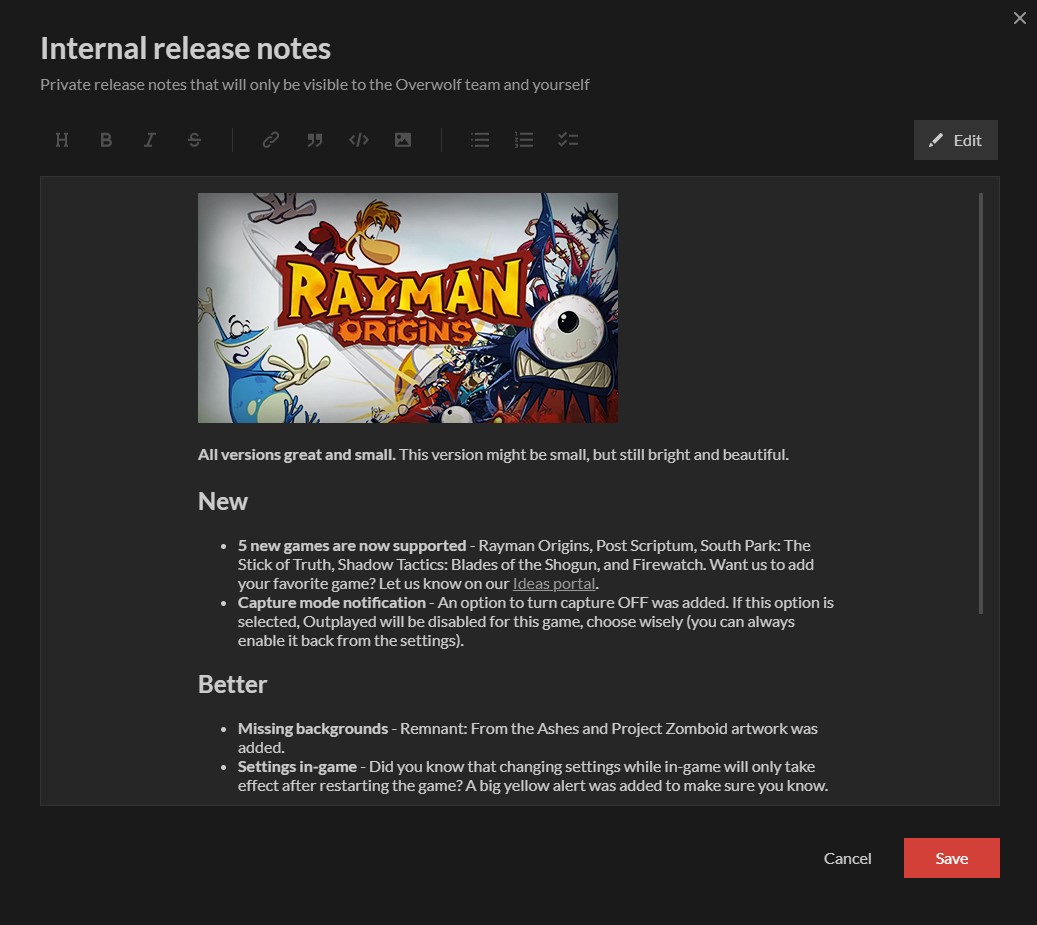
At any point, you can use the Cancel and Save buttons inside of the release notes editor, which correspond to the Discard changes and Save buttons of The Footer Toolbar.
Public release notes also contain two extra toggles:
Publish- Whether the release notes should bepublished.- When turned off, you can use the release notes editor to create a "draft" for your new version. For release notes you
wish to keep internal, use the
Internal release notesinstead. - When turned on, your notes, and any changes made to them, will be available for everyone to read.
- When turned off, you can use the release notes editor to create a "draft" for your new version. For release notes you
wish to keep internal, use the
Important- Whether this version is consideredimportant. Use this to mark major versions or time-critical updates.
Public Release Notes Preview
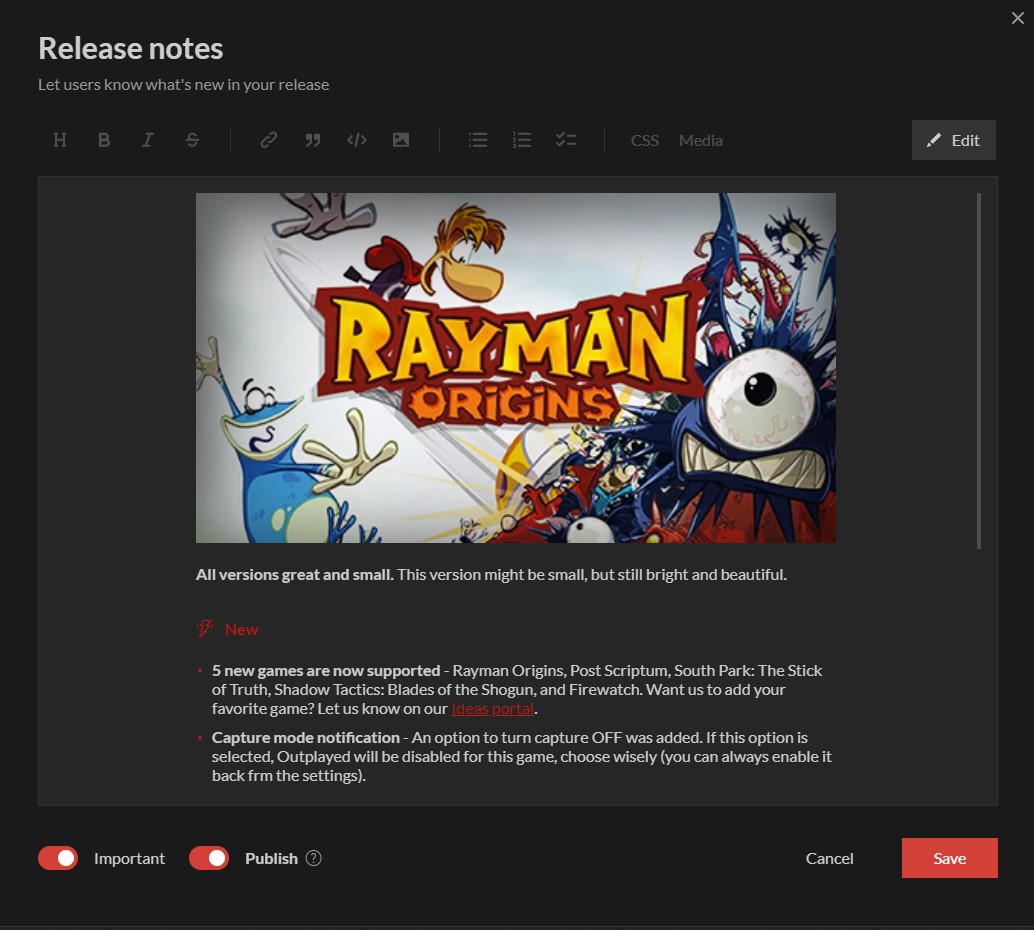
Keep in mind that changes made to the public release notes of an app will take approximately ~5 minutes to update on the endpoint.
Release Notes Endpoint
The developer's console exposes the "compiled html" of pubic release notes of every app, through the following API endpoint:
`https://console-api.overwolf.com/v1/apps/${app-id}/versions/${version}/release-notes/${page}`
Where:
app-id- your app's unique id.version- The most recent version you wish to display.page- The changelogs page number. Every page contains up to three changelogs.
The endpoint will then return the following json:
{
"versions": [
{
"important": boolean,
"version": string,
"html": string,
"timestamp": number
}
],
"meta": {
"perPage": number
}
}
Any version without a published public changelog will be skipped.
The versions array will display up to three versions. If it runs out of versions to display before then,
it will only be filled by the remaining versions. In the next page after that, it will then be completely empty.
Changelog page numbers start from 1. If you check for page 0, it will just be treated as page 1.
Example Values
For this example, we will use use Workflowy. As such:
app-id-npijmgiaiiemcnijaljcfddgeihcbifdbhpffiheversion-6.0.71
The link will then be:
`https://console-api.overwolf.com/v1/apps/npijmgiaiiemcnijaljcfddgeihcbifdbhpffihe/versions/6.0.71/release-notes/${page}`
At the time of writing, this will include three versions with release notes.
- Page 0
- Page 1
- Page 2
The result for page 0 would be:
{
"versions":[
{
"important":true,
"version":"6.0.69",
"html":"<p>test</p>",
"timestamp":1662018568162
},
{
"important":true,
"version":"3.1.5",
"html":"<figure><img src='http://content.overwolf.com/outplayed/release-notes/069/release-notes-hero.webp'></figure>\n<p><strong>All versions great and small.</strong> This version might be small, but still bright and beautiful.</p>\n<h2 class='new'>New</h2>\n<ul>\n<li><strong>5 new games are now supported</strong> - Rayman Origins, Post Scriptum, South Park: The Stick of Truth, Shadow Tactics: Blades of the Shogun, and Firewatch. Want us to add your favorite game? Let us know on our <a href=\"https://ideas.outplayed.tv/\">Ideas portal</a>.</li>\n<li><strong>Capture mode notification</strong> - An option to turn capture OFF was added. If this option is selected, Outplayed will be disabled for this game, choose wisely (you can always enable it back from the settings).</li>\n</ul>\n<h2 class='improved'>Better</h2>\n<ul>\n<li><strong>Missing backgrounds</strong> - Remnant: From the Ashes and Project Zomboid artwork was added.</li>\n<li><strong>Settings in-game</strong> - Did you know that changing settings while in-game will only take effect after restarting the game? A big yellow alert was added to make sure you know.</li>\n</ul>\n<h2 class='bugs'>Fixed</h2>\n<ul>\n<li><strong>Capture mode notification</strong> - Allow using numeric keypad in the notification hotkeys. We like hotkeys, especially in the winter.</li>\n<li><strong>Video editor</strong> - Videos with aspect ratios different than project settings were stretched to fit. Although stretching is good for your health, we fixed it.</li>\n</ul>\n<p>Have a great idea for Outplayed? Let us know on our <a href=\"https://ideas.outplayed.tv/\">Ideas portal</a>, or talk to us directly on our <a href=\"https://discord.gg/MatrVYK\">Discord server</a>.</p>\n<p><strong>See you in the next version,<br>\nThe Outplayed team</strong></p>",
"timestamp":1643024580643
},
{
"important":false,
"version":"3.0.33",
"html":"<p>3.0.33 release notessssssss</p>",
"timestamp":1643036589211
}
],
"meta":{
"perPage":3
}
}
Which is the same as the result for page 1.
The result for page 1 would be:
{
"versions":[
{
"important":true,
"version":"6.0.69",
"html":"<p>test</p>",
"timestamp":1662018568162
},
{
"important":true,
"version":"3.1.5",
"html":"<figure><img src='http://content.overwolf.com/outplayed/release-notes/069/release-notes-hero.webp'></figure>\n<p><strong>All versions great and small.</strong> This version might be small, but still bright and beautiful.</p>\n<h2 class='new'>New</h2>\n<ul>\n<li><strong>5 new games are now supported</strong> - Rayman Origins, Post Scriptum, South Park: The Stick of Truth, Shadow Tactics: Blades of the Shogun, and Firewatch. Want us to add your favorite game? Let us know on our <a href=\"https://ideas.outplayed.tv/\">Ideas portal</a>.</li>\n<li><strong>Capture mode notification</strong> - An option to turn capture OFF was added. If this option is selected, Outplayed will be disabled for this game, choose wisely (you can always enable it back from the settings).</li>\n</ul>\n<h2 class='improved'>Better</h2>\n<ul>\n<li><strong>Missing backgrounds</strong> - Remnant: From the Ashes and Project Zomboid artwork was added.</li>\n<li><strong>Settings in-game</strong> - Did you know that changing settings while in-game will only take effect after restarting the game? A big yellow alert was added to make sure you know.</li>\n</ul>\n<h2 class='bugs'>Fixed</h2>\n<ul>\n<li><strong>Capture mode notification</strong> - Allow using numeric keypad in the notification hotkeys. We like hotkeys, especially in the winter.</li>\n<li><strong>Video editor</strong> - Videos with aspect ratios different than project settings were stretched to fit. Although stretching is good for your health, we fixed it.</li>\n</ul>\n<p>Have a great idea for Outplayed? Let us know on our <a href=\"https://ideas.outplayed.tv/\">Ideas portal</a>, or talk to us directly on our <a href=\"https://discord.gg/MatrVYK\">Discord server</a>.</p>\n<p><strong>See you in the next version,<br>\nThe Outplayed team</strong></p>",
"timestamp":1643024580643
},
{
"important":false,
"version":"3.0.33",
"html":"<p>3.0.33 release notessssssss</p>",
"timestamp":1643036589211
}
],
"meta":{
"perPage":3
}
}
Which is the same as the result for page 0.
The result for page 2 would be:
{
"versions":[
],
"meta":{
"perPage":3
}
}
Which is empty, since there are only 3 published release notes from this version.
The App Channels API
As mentioned above, you can implement the channels feature directly into your app using the app channels API.
You can read the currently installed channel of your app using overwolf.settings.getExtensionSettings().
overwolf.settings.getExtensionSettings(console.log) //{"settings":{"channel":"beta"},"success":true}
You can change the current channel using overwolf.settings.setExtensionSettings().
overwolf.settings.setExtensionSettings({ channel: "beta" }, console.log)
While testing channels each have their own unique name, the production channel does not.
In order to reference the production app channel, use channel: ""
App Channels Sample App
For a full example of how to utilize app channels, you can download our App Channels sample app, which demonstrates how to use the app channels feature and API.
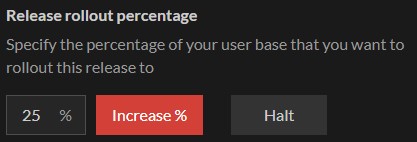 In this section, it is possible to edit a "phased" version's
In this section, it is possible to edit a "phased" version's 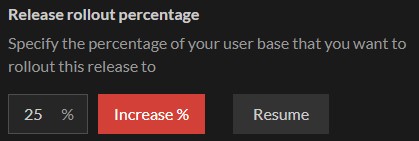 In this section, it is possible to edit a "phased" version's
In this section, it is possible to edit a "phased" version's